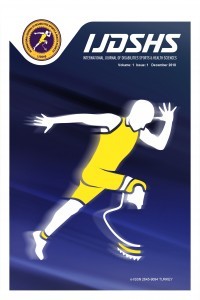Evaluation of FMS Scores of Competitive CrossFit Athletes by Gender
Evaluation of FMS Scores of Competitive CrossFit Athletes by Gender
Crossfit, FMS, Gender Injury prevention,
___
- Bardenett, S.M., Micca, J.J., DeNoyelles, J.T., Miller, S.D., Jenk, D.T., Brooks, G.S. (2015). Functional movement screen normative values and validity in high school athletes: Can the FMS be used as a predictor of injury? Int J Sports Phys Ther;10(3):303-308.
- Chorba, R.S., Chorba, D.J., Bouillon, L.E., Overmyer, C.O., Landis, J.A. (2010). Use of a functional movement screening tool to determine injury risk in female collegiate athletes. N Am J Sports Phys Ther. 5(2):47-54
- Claudino, J.G., Gabbett, T.J., Bourgeois, F., et al. (2018). Crossfit overview: systematic review and meta-analysis. Sports Med Open; 26;4(1):11
- Clifford, C. (2016). The Founder Of Crossfit Credits His Success To One Simple Secret. In: CNBC.
- Cook, G., Burton, L., Hoogenboom, B. (2006). Pre-participation screening: the use of fundamental movements as an assessment of function - part 1. N Am J Sports Phys Ther;1:62–72.
- Cook, G., Burton, M., Hoogenboom, B., Voight, M. (2014). Functional movement screening: the use of fundamental movements as an assessment of function. Int J Sports Phys Ther; 9(3):396-409.
- Feito, Y., Heinrich, K. M., Butcher, S. J., and Poston, W. S. C. (2018). High-intensity functional training (HIFT): Definition and research implications for improved fitness. Sports; 6(3):76.
- Frost, D. M., Beach, T. A., Callaghan, J. P., And McGill, S. M. (2012). Using the Functional Movement Screen™ to evaluate the effectiveness of training. The Journal of Strength & Conditioning Research;26(6),1620-1630.
- Gulgin, H., Hoogenboom, B. (2014). The functional movement screening (FMS)™: an inter-rater reliability study between raters of varied experience. Int J Sports Phys Ther; 9:14–20.
- Kiesel, K.B., Plisky, P.J., Voight, M.L. (2007). Can serious injury in professional football be predicted by a preseason functional movement screen. N Am J Sports Phys Ther;2(3):147-158.
- Letafatkar, A., Hadadnezhad, M., Shojaedin, S., Mohamadi, E. (2014). Relationship between functional movement screening score and history of injury. Int J Sports Phys Ther; 2014;9(1):21-27.
- Needham, R.A., Chockalingam, N. (2015). The effect of an intervention program on functional movement screen test scores in mixed martial arts athletes. J Strength Cond Res;29:219–25.
- Rodriguez, M.A., Garcia-Calleja, P., Terrados, N., Crespo, I., Del Valle, M., Olmedillas, H. (2021). Injury in CrossFit(R): a systematic review of epidemiology and risk factors. Phys Sportsmed; 1-8.
- Sarıçam, H., Madan, M., And Soykan, A. (2022). The structure and culture of Crossfit as a fitness trend in Turkey.Journal of Physical Education and Sports Sciences ;24(1):16-22.
- Shim, S. S., Confino, J. E., Vance, D. D. (2023). Common orthopaedic injuries in crossfit athletes. Journal of the American Academy of Orthopaedic Surgeons;31 (11):557-564.
- Stracciolini, A., Quinn, B., Zwicker, R. L., Howell, D. R., and Sugimoto, D. (2020). Part I: CrossFit-related injury characteristics presenting to sports medicine clinic. Clinical Journal of Sport Medicine; 30(2):102-107.
- Summitt, R.J., Cotton, R.A., Kays, A.C., Slaven, E.J. (2016). Shoulder injuries in individuals who participate in crossfit training. Sports Health; 8(6):541-546.
- Szajkowski, S., Dwornik, M., Pasek, J., And Cieślar, G. (2023). Risk Factors for Injury in CrossFit®-A Retrospective Analysis. International Journal of Environmental Research and Public Health;20(3), 2211
- Toledo, R., Dias, M.R., Souza, D., et al. (2021). Joint and muscle injuries in men and women CrossFit(R) training participants. Phys Sportsmed; 50:1–7.
- Weisenthal, B.M., Beck, C.A., Maloney, M.D., DeHaven, K.E., Giordano, B.D. (2014). Injury rate and patterns among crossfit athletes. Orthop J Sports Med; 2(4):2325967114531177.
- Yayın Aralığı: Yılda 3 Sayı
- Başlangıç: 2018
- Yayıncı: Nevzat DEMİRCİ
Evaluation of FMS Scores of Competitive CrossFit Athletes by Gender
Üstün TÜRKER, Mustafa Barış SOMOĞLU, Efecan TEZCAN, Mine KOÇ
Gait Imbalances of Middle-Aged Sedentary Populations
Hasan Hüseyin YILMAZ, Murat KALDIRIMCI
Investigation of the Foot Arch Postures of Sport Sciences Students According to Some Variables
Esra KÜRKCÜ AKGÖNÜL, Tolga ŞAHİN, Beste Can KOÇ, Recep Nur UZUN
Yetkin Utku KAMUK, Zafer DOĞRU
Investigation of the Effects of Game and Yoga Training on Social Integration and Subjective Wellness
Determination of Post-Earthquake Trauma Levels of University Students
